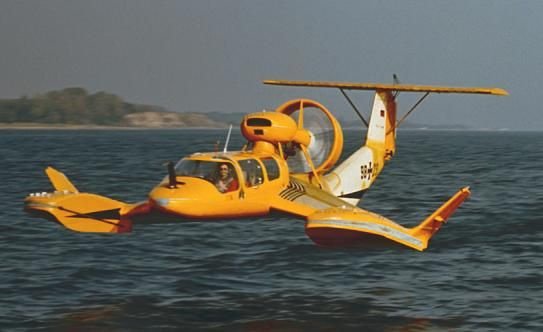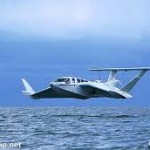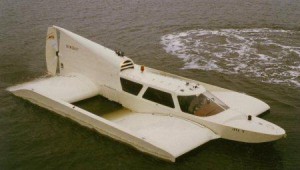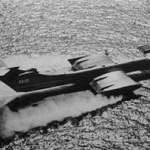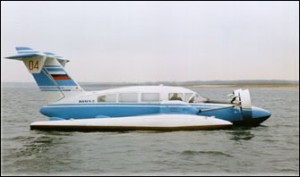Types Of Wig-crafts
WIG-craft are not aircraft. Complications from the proximity to the ground, creates an additional design criteria that is not required for aircraft designs. Both, flying close to a surface, and long relative take off distances (compared to aircraft) require a WIG craft to be vertically auto stable.
Secondly, the small wings on a WIG Craft don’t create as much lift an aircraft, so take off often requires significantly more power than flight.
Over the years, different WIG-craft designs have been developed, with each design finding different ways to address the stability and take-off issues. The following highlights the most common designs.
REVERSED DELTA
This early platform was first created by Lippisch. The reversed delta wing is very stable because of its wing platform. As a result, only a small horizontal stabilizer is necessary.
One down side to these craft, is that the power required to get over the hump speed of the hull can be twice that of cruising. As a result, once the craft is flaring the power can be reduced by 50% for cruising, meaning more engine is on board than is needed. These craft also have a limited range of speed between take off and cruise, do to the twist in the wings. These designs typically utilize V-hulls similar to a speed boat. These crafts can also “jump”.
Fischer Flugmechanik (Germany) developed several crafts based on the Lippisch reversed Delta wing form.
Some examples of Reverse Delta WIGs include the Lippisch X-112, X113, X114 and the Airfisch series. The Lippisch X114 and the Flightship FS8 are shown here.
Tandem
The tandem wing concept uses two small wings in line. The wings are set in different angles in respect to each other. This configuration provides excellent stability. No horizontal stabilizer is necessary, but the flaring height is relatively low.
The thumb nail to the right is a Joerg VI.
Ekranoplan
The Ekranoplan is a Russian invention. These crafts have wings with a very low aspect ratio of 1 to 4 with endplates and flaps. For take-off, these craft blow air under the wings to establish an air cushion. At cruising speed propeller thrust is tilted in a more vertical position for more forwards trust i.e. speed.
Large models use separate engines for trust and under wing blowing in front of the wing. All Ekranoplans have huge horizontal stabilizers. These crafts are also called PAR-WIG crafts (Power Augmented Ram Wing in Ground Effect). Many have been built in different sizes, the largest exceeding 500 tons. Russian companies are the only companies who can deliver now.
Dynamic Hovercraft
While this craft is in hover mode, the lift fan fills the skirt with air generating a cushion of air to elevate craft. If on land, the craft is lifted from the surface. If on water, the water benieth the pressurise area is depressed such that the weight of the depressed water equals the weight of the craft. Much like a planing hull boat, The hovering craft can accellerate to the point where the water can not get out of the way fast enough, so the craft is “over the hump” (similar to a plaining hull being on plane). It is difficult to compare which technique has less drag, but hover craft typically have lower fuel burn to similar speed planing hulls.
In dependent of efficiency, these crafts do have the advantage that they can drive up on a beach while supported on cushion.
At a speed of about 43 knots the aerodynamic lift from the wings can support the craft in WIG mode. At this point, the lift fan can be switched to neutral and no longer draw power from the engine. Because this craft hovers before take off, it can also be used on land, ice or snow.





